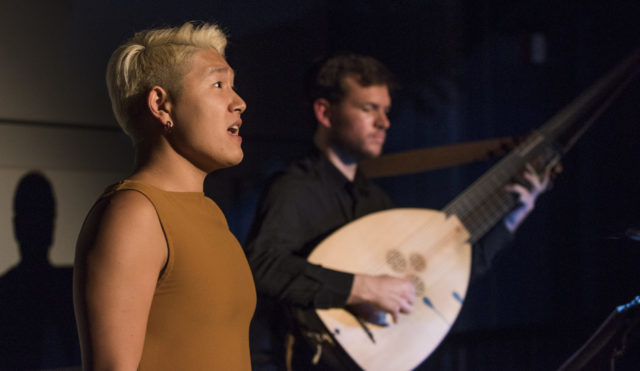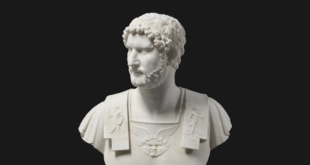
All concerned at the very handsome Harris Theater are to be congratulated for staging Monteverdi’s “L’Orfeo,” the first of the three works by that composer to be performed as part of the windup of the international ‘Monteverdi 450’ tour. (A production of this trio of early operas concluded the tour at the Lincoln Center in New York.)
For one like myself, who has experienced and has come to love opera based on seeing and hearing operas strictly from the Classic and Romantic periods (Mozart through Puccini) for over half a century, “L’Orfeo” definitely presented some revelations.
Most importantly, Claudio Monteverdi (1567-1643) was a truly great composer. His music is powerful, always leading the ear, and is melodically, harmonically and rhythmically incredibly varied and broad in scope. It wasn’t until I experienced “L’Orfeo” on stage at the Harris that I realized just how great of a composer he was!
Another revelation was that, from Monteverdi’s opera, it was easy to see why opera became so popular in so short a time. This is analogous for many of us to the quick appeal of TV, the internet and cell phones. If we accept that the first opera was composed in 1597, then “L’Orfeo,” written in 1607, had to be one of the first of its kind. From what I witnessed on Thursday night, it is mind-boggling to imagine how a performance of this opera must have struck the spectators of those early years in the 17th century. Those folks simply could not have heard anything like it in their lives!
And even though the approach of Monteverdi and his librettist, Alessandro Striggio, to creating “L’Orfeo,” is distinctly different than composer-librettist teams in the Romantic period, it is nevertheless obvious how the early opera had such a profound influence on the evolution of the art’s formal development.
Conceptually, the first operas were poetry supported by music. In other words, the music was supposed to be subordinate to the text. And “L’Orfeo” is a good example of that. The words — the story — goes on and on, and nothing gets repeated for the sake of a melodic phrase.
The music (again, conceptually) appears to exist simply to color and vivify the text — nothing more than that. When I took my seat and looked at the stage, I saw that all the instruments and music stands were set up there — almost as if there was to be a concert version of the opera. As the opera progressed, the singers moved in and around the instruments on stage. Ironically, although the instruments were always quite visible, one’s attention was focused on the singers. In “L’Orfeo,” there are a number of brass-dominated instrumental parts, but also many vocal solos, ensembles and rousing choruses. About half the singers were originally “castrati,” which no doubt also evoked extra audience fascination with the singing. So the trend for opera to become a singers’ art must have been well-established with “L’Orfeo.”
The ending of “L’Orfeo” is not the one that comes from the Ovid/Virgil myth, as does the rest of the opera. Like Verdi, Monteverdi, besides being a great composer, was also a man of the theater. His librettist, Striggio, as was the custom, used the Orpheus myth’s original ending, in which the hero is torn to pieces by the Maenads (wild women followers of Dionysus). Monteverdi realized that Orfeo was a sympathetic character who, after losing Eurydice and everything, deserved a happier fate. Thus he had Striggio re-write the ending in the manner of a Greek “Deus ex machina,” where Apollo came down from heaven to resurrect the mythical singer as starry constellation.
As for the performance itself, it is hard to escape the fact that what is presented is the brilliant concept of one individual, conductor and director Sir John Eliot Gardiner. I personally have never seen a more disciplined group of singers and musicians, all working, and very successfully, too, to achieve the restoration of a very important opera. The program also lists Elsa Rooke as a director, but what I saw is clearly the fruit of a single mind, which has to be Sir John’s.
The instruments were separated into groups for most effective sound production — the bowed and treble strings in one block and the bass strings in another. The brass would come and go when needed, as would the chorus. And early as this opera may be, its score is not all that simple. There are 41 different instruments called for, 11 vocal soloists plus more singers for various choruses and ensembles. With all this complexity, when the characters (and occasionally even some of the instrumentalists) moved about in very limited spaces, no one was tenuous, there was no equivocation or hesitation. Again, it is a tribute to Sir John and the respect he engenders from this very young group of performers, that all the moving parts churn on like a well-oiled machine, to the benefit of the paying spectators.
I would bet that most of the audience, like myself, are opera lovers, which means listening to music of the late-18th through early-20th centuries. The music of “L’Orfeo” is more Renaissance style than Baroque, and is very different than what we are used to hearing. If so, we would have perked up to two singers who could easily be imagined singing on the “normal” opera stage, and who in fact do just that. One of these is tenor Krystian Adam, who sings the title role. His stamina in this epic part is incredible. He has a very wide range with a very well supported high register. That he has sung lead roles in a number of Mozart and Verdi roles at La Scala, Covent Garden and La Fenice is not surprising.
I have to say that bass Gianluca Buratto, who sings Caronte and Plutone in this opera was my personal favorite. His deep, vibrant instrument is extremely powerful, yet he is still very much a lyric bass, who can sing with great flexibility and sensitivity.
Sir John Eliot Gardiner approaches the costuming and makeup with restraint. I have seen it done differently, with exotic costumes, masks, etc., but I actually liked it better the way it was done at the Harris. The focus was clearly more on the singing and playing.
This production was memorable, and enlightening. I’m very glad I was able to see it!
 Fra Noi Embrace Your Inner Italian
Fra Noi Embrace Your Inner Italian






